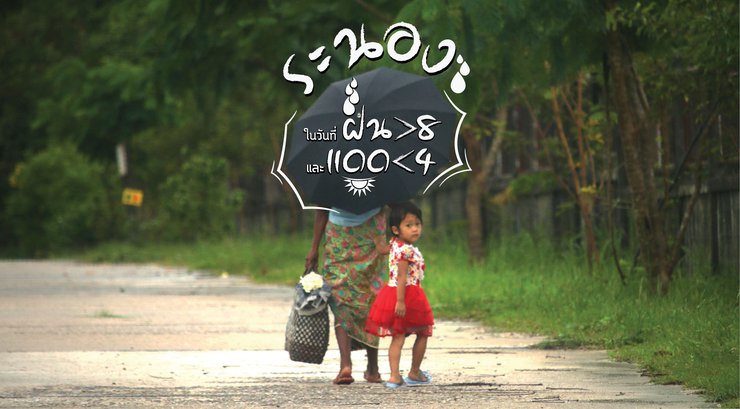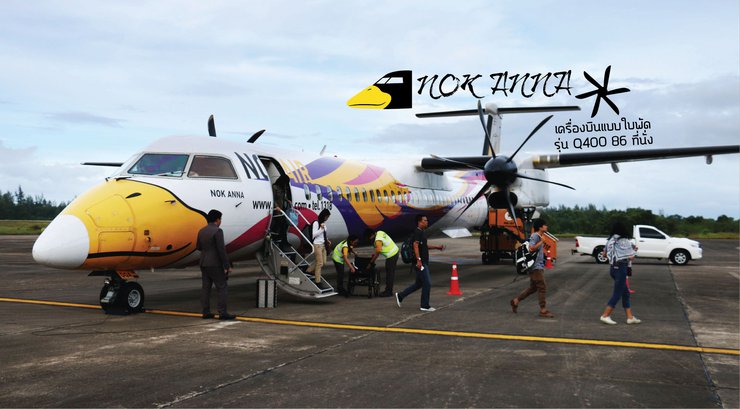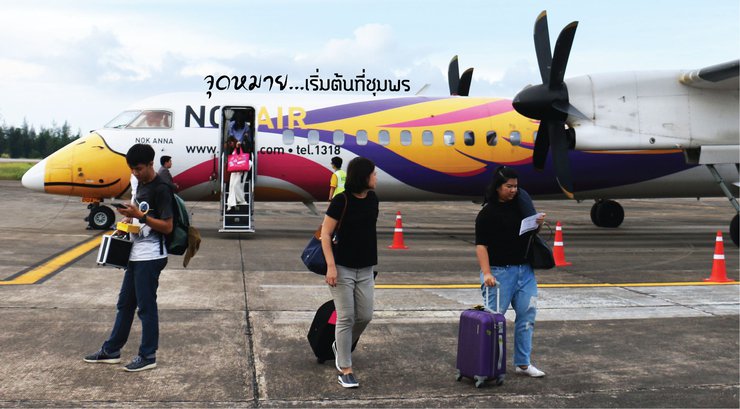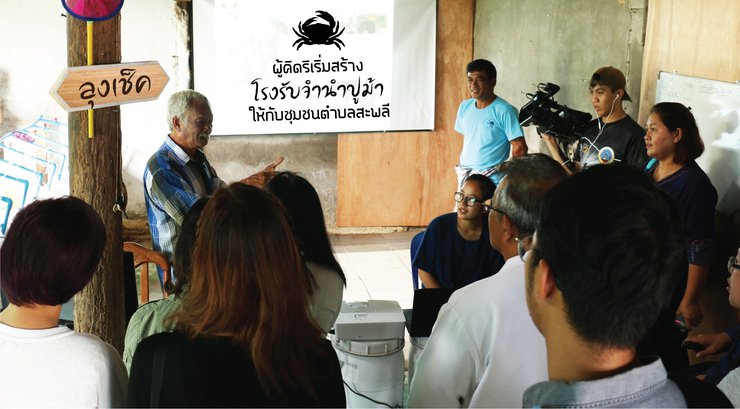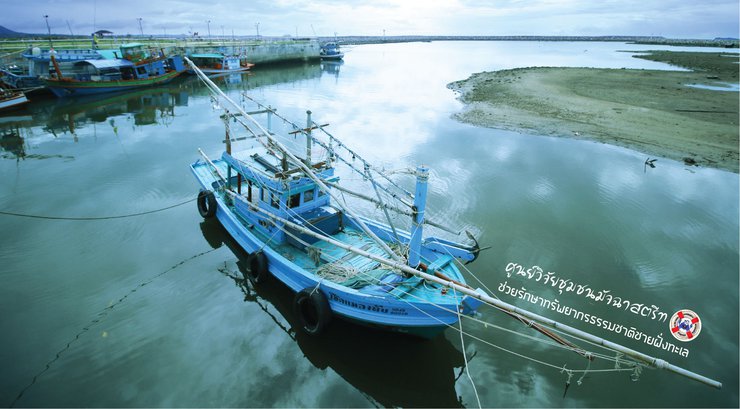




Our previous trip to Ranong gave us a clear understanding of the saying "8 days of rain, 4 days of sunshine." However, returning to Ranong during the rainy season exceeded our expectations. We were well-prepared, but the early morning departure was a challenge. We had to arrive at the airport at 4:00 AM, check in and drop off our luggage, and wait for our 5:00 AM flight. This time, we flew from Don Mueang Airport to Chumphon on Nok Air, which names all of its planes with the prefix "Nok." The plane we boarded was named NOK ANNA, a small aircraft that we were flying for the first time. We were a little excited, and when we saw the size of the plane as we walked to board, we smiled to ourselves and got on. We found a seat that didn't feel as cramped as the larger planes we had flown on before. The takeoff went smoothly, and the flight attendants provided us with water and snacks to keep us entertained, making the hour-long flight pass quickly. We arrived at Chumphon Airport without incident.
Nok Air Head Office
Location: Nok Air Public Company Limited
17th Floor, Ratchagarn Building, 3 Sathorn Tai Road, Yannawa Subdistrict, Sathorn District, Bangkok 10120
Contact number: .1318









We then boarded a vehicle and headed to the Baan Mai Khlong Homestay for breakfast. Here, we were served a light breakfast of rice porridge with whole mackerel fish, followed by crab fried rice, dessert, and fruit. This first meal was a delicious introduction to the community's efforts to preserve its traditional way of life through ecotourism. The homestay offers various activities, including mangrove forest boat tours, observing the lives of local fishermen, and accommodation and meals. We were welcomed by Mr. Somchoke, who led us to the Crab Bank, a community-based marine animal nursery. Uncle Check, or Professor Check as he is affectionately known in the community, was the mastermind behind the Crab Bank in Sapli Subdistrict, Chumphon Province. Uncle Check donated his old house to be used as the Machcha Street Community Research Center. The center's primary project is the conservation of coastal marine resources, with the Crab Bank being the main focus. The community has also been actively creating homes for fish by sinking abandoned shrines into the sea at designated locations, resulting in the creation of "Chumphon Chic," a unique underwater habitat. They have also built a traditional Thai house for fish and recently submerged an old bus and a decommissioned naval ship to enhance the underwater landscape, creating a diving spot that promotes ecotourism and community-based tourism. The Crab Bank is also currently involved in the cultivation of the popular sea grapes seaweed.
Wooden House by the Canal Homestay
Location: Bang Son Subdistrict, Pathio District, Chumphon Province
Contact numbers: 080-7791650, 095-7931957
www.facebook.com/homestaybangson
Pooma Pawn Shop
Location: Community Research Center, Matsastreet, Sapli Subdistrict, Chumphon 86230, Thailand.
Contact number: 082 7007475




After leaving Chumphon, we headed towards Ranong to visit Wat Suwannakhiri (Wat Pak Chan), also known as Wat Na Mueang. This temple houses the Phra That Intharawan, a replica of the Mahazedi Pagoda in Yangon, Myanmar. However, our arrival in Ranong was met with heavy rain, forcing us to seek shelter in a nearby pavilion. Inside, we found the revered Tep Kasip (a female deity) and Tep Thanjai, both known for their potent sacredness. We then ventured to the renowned Salapao Thap Li village, where we indulged in the delectable soft buns filled with generous fillings at Han Yik Yuen, the original Salapao shop in Thap Li. Besides the Salapao, we also enjoyed savory dumplings paired with hot tea, a perfect complement to the rich flavors.
Suwannakeeree Temple
Location: 11 Moo 4, Pak Chan Subdistrict, Mueang District, Ranong Province
Contact number: 077-873502
Han Yuanyuan
Location: 29 Talat Thap Li, Mamu Subdistrict, Kra Buri District, Ranong Province
Contact number: 081 891 1900
Open: 8:00 AM – 5:00 PM





Many people hesitate to eat a lot because lunch is waiting for us at Kong Valley, which is already prepared for us with a full table of spicy southern food such as stir-fried curry paste, stir-fried shrimp with bitter leaf in coconut milk, and large fried fish served with fresh vegetables and chili paste that perfectly complement each other. While eating, we listened to the sound of the rain that has started again, with occasional strong winds. The sound of the water continues to flow without stopping. All the sounds rise and fall alternately like musical instruments playing along with the sound of Mr. Kong's conversation, which tells stories about coffee and extends to various personal matters. It is both enjoyable and informative, making us feel full without realizing it. Then we walked with umbrellas through the rain to the coffee roasting factory, where Mr. Kong demonstrated and worked with us. We participated in a D.I.Y. activity, starting from roasting, grinding, brewing, and drinking. We learned a lot about coffee, such as the fact that Robusta coffee can be grown anywhere, is a fruit with three layers of skin, and stays on the tree longer than other fruits, for a period of 9-10 months. And if we plant just 4-5 coffee trees, we will have coffee to drink for the rest of our lives. The rules for roasting the freshest coffee in the world have three points: every bean must touch metal, ripen by rolling, and from the heat that passes through the metal. Even those who don't drink coffee like us have to ask for a taste because of the smell. Plus, there are fried buns to eat with it, which are absolutely delicious. And before leaving, Mr. Kong also gave us a final treat by letting us drink Robusta coffee flower tea, which is very fragrant. Most importantly, it only blooms once a year and can only be harvested for 2-3 days. After being dried in the sun, it is roasted to create sweetness. Those who like flower tea must try it because it is very difficult to find. This place has a lot to offer in terms of learning, and it is an agricultural tourism community enterprise and a model community learning center of the Bank for Agriculture and Agricultural Cooperatives (BAAC). If anyone is interested, they can talk to Mr. Kong and join in the fun of making D.I.Y. coffee amidst the lush nature.
GONG Coffee & Valley
Location: 62/1 Moo 8, A. Kra Buri, Ranong Province
Contact number: 087 268 1285







Today's another destination is the Si-Iu-Chun-Sin Soy Sauce Factory, which still uses traditional methods passed down through generations. We visited the boiling room, which has two large pans for boiling brown sugar from the Northeast and soybeans from the North. They use firewood from rubber trees that can no longer produce latex, which are fermented in open-air jars. The entire process of making soy sauce, a staple of Ranong, takes a year. As the rain continued to fall, we tried our hand at making "Salapao Taphli," a local steamed bun we had tasted earlier. It wasn't easy. Kneading the dough was manageable, and filling it was simple, but folding the dough to seal it proved challenging. Many of us laughed and had fun while attempting it. Later, Mr. Hack, the owner of the soy sauce factory, prepared a dish of fried fish with black bean and ginger sauce for us to try. It was so delicious that we wished we had another plate of hot rice. By 6 pm, the rain had stopped, and we headed to a familiar restaurant for dinner. It took less than half an hour to reach the restaurant, where we were greeted with fresh coconut water served in the whole fruit. The sweet and tender coconut flesh was refreshing. Next came grilled river prawns with juicy heads and long whiskers, perfect for peeling and snacking on while enjoying the lively atmosphere created by the staff's dance performance. Other dishes, such as stir-fried "Bai Liang" with egg, fried mackerel with shrimp paste, prawns in tamarind sauce, fresh vegetable chili dip, and "Pla Lumpu Kluai Suan," were equally delicious and disappeared in no time. We finished the meal with the restaurant's special "Bai Liang" juice and returned to our accommodation feeling pleasantly full. For our first night, we stayed at the stylish Nam Sai Khao Suay Resort, which welcomed us with a refreshing drink at the lobby. The resort is newly opened and has a clean and well-organized layout, including a swimming pool and a breakfast room on the upper floor. We stayed in a spacious superior room with a single bed. The room was well-divided, with a wardrobe near the bathroom, perfect for getting dressed. The bathroom was also well-partitioned, with a wet area for the shower, complete with a curtain, and a dry area where you could comfortably blow-dry your hair. The room had an electric kettle for making tea or coffee, a TV, air conditioning, a refrigerator, and even some fruit in case you get hungry late at night. The balcony at the back was spacious and private, separated from the neighboring rooms, offering a relaxing view of the trees and flowers. When the door was closed, the room was very quiet, with no outside noise, including the sound of the rain that continued to fall throughout the night.
Zi-Yi Jun-Sin Hospital
Location: 11/4 Soi Chart Sarn 14, Moo 1, Bang Rin Subdistrict, Mueang District, Ranong 85000
Contact number: 077 811 049
Open Monday - Friday: 7:30 AM - 8:00 PM.
Familiar Tongue Restaurant
Location: 1/17 Chonlaro Rd., Mueang District, Ranong Province (Enter via Raksawarin Hot Spring)
Contact number: 077-822863
Open daily: 10:00 AM – 9:00 PM.











The morning began with a breathtaking view from the second floor lobby. Lush green mountains shrouded in mist greeted us as we enjoyed a breakfast buffet of fruits, water, bread, and a variety of main courses. We opted for a hearty breakfast set with omelets, sausages, bacon, and ham, served on a large plate. Settling into comfortable seats with plush cushions, we savored the view and fueled up for the day ahead. At 8 am, we boarded a traditional wooden songthaew with a guide who would introduce us to the local attractions. Our first stop was the Raksa Warin hot spring, where we could participate in hot yoga or soak our feet in the therapeutic mineral water. As we relaxed in the warm water, the sky darkened, and soon heavy rain poured down, a typical occurrence in Ranong. After the rain subsided, we enjoyed a delicious onsen egg before heading to the Tay Te Eiy Shrine. Mr. Arisiri Surachetmethikul, the secretary of the shrine's foundation, shared the history and significance of this sacred place. The Tay Te Eiy Shrine, also known as Po Seng Tai Te, is considered the guardian deity of Ranong. This centuries-old shrine houses the revered Tay Te Eiy deity, or Po Seng Tai Te, who is deeply respected by the local community. In the past, many Chinese people believed that Tay Te Eiy was a physician who treated the emperor in China and possessed the ability to cure all ailments. Consequently, people would visit the shrine to seek remedies for their illnesses. Following tradition, we participated in the rituals guided by the foundation secretary and received medicinal herbs for our ailments. The enduring faith and belief in Tay Te Eiy continue to this day. If you ever find yourself in Ranong, be sure to visit the Tay Te Eiy Shrine and offer your prayers.
Nam Sai Khao Suay Resort
Location: 14/19 Phetkasem Rd., Khao Niwet Subdistrict, Mueang District, Ranong 85000
Contact number: 087-2228886, 077-989855-6
Tai Te Eia Shrine
Location: 19 Rueangrat Road, Khao Niwet Subdistrict, Mueang District, Ranong 85000
Contact number: 077 835 195
Open daily from 8:00 AM to 6:00 PM.




Before noon, we visited the beautiful replica of Ratnarangsarn Palace, built to replace the original palace that was destroyed. The original palace was located at the site of the Ranong City Hall. It was built by Phraya Damrong Sucharit Mahisorn Phakdi (Ko Sim Kong) as a memorial to the three monarchs who visited Ranong: King Rama V, King Rama VI, and King Rama VII. The replica of Ratnarangsarn Palace was built based on photographs and a royal letter written by King Rama V in official records. It is a 1:100 scale model made of teak and golden teak wood. In front of the palace is a public park with a statue of a miner, indicating the abundance of minerals in the area during that time. At noon, we traveled to Baan Thian Si. In Chinese, "thian" means heaven and "si" means gift. Therefore, the house is considered a gift from heaven. The owner, Ko Sup, has opened his 100-year-old house as a living museum, telling the stories of the first generation of Chinese people in Ranong. It is also a community learning center for Ranong Province and does not charge an entrance fee. We walked around and saw many antique items and the history of the Na Ranong family.
Ratchawat Ratnarangsarn Palace (replica)
Location: Ratnarangsarn Hill (near Ranong Provincial Hall), Khao Nives Subdistrict, Mueang District, Ranong Province 85000
Contact number: 094 148 8518
House of the Heavenly Candles
Location: 7 Dab Kadee Road, Khao Niwet Subdistrict, Mueang District, Ranong Province
Contact number: 081 088 2629
Operating Hours: 6:00 AM - 8:30 PM



This afternoon, we had the pleasure of enjoying a delicious lunch at Khao Hom Restaurant. The open-air space offers a variety of seating areas, perfect for savoring the bold flavors of southern Thai cuisine. From the tangy sourness of the curry to the fragrant shrimp stir-fried with shrimp paste and sataw beans, each dish tantalized our taste buds. The fresh shrimp chili paste paired perfectly with an assortment of vegetables, while the crispy pork belly provided a welcome respite from the spiciness. To round off the meal, we indulged in a refreshing fruit salad with a touch of sweetness. With our energy replenished, we headed to the lush greenery of Ton Phet Green Nursery Garden.
Ms. Tei welcomed us with a refreshing herbal drink, butterfly pea flower with lemon. She shared that the inspiration for this place came from her feeling of exhaustion and frustration with the situation in Bangkok. She decided to return to her hometown and discovered that she already had the resources she needed right here. The legacy she witnessed since childhood, a garden with various trees, felt like growing up together with many of the plants. Combined with her grandmother's culinary skills from her restaurant, "Jhe Hiang," Ms. Tei has built upon these foundations, incorporating the sufficiency economy philosophy of King Rama IX. This place offers a variety of services, including accommodation, body massage, and foot massage. We can walk around and pick fresh vegetables, savor pesticide-free fruits, and use them to create various dishes to enjoy amidst nature, under the shade of large trees, or by the river flowing from Ton Phet Waterfall, where we can also take a refreshing dip. Today, we learned how to make one of her grandmother's signature dishes from the very first step, salted egg sausage. It's a dish that seems simple, but the steps require meticulous attention and a fair amount of time. While her grandmother was teaching us and we were following the steps, Ms. Tei brought out a pre-made salted egg sausage for us to taste. As we cooked and tasted, enjoying ourselves, the sky gradually darkened, and within seconds, both wind and rain lashed down, catching us off guard. We took shelter from the rain for a while, but it seemed like it wouldn't stop anytime soon. Our activities continued. Supplies were brought out and prepared for us to make herbal compress balls. We pounded and ground various herbs to release their fragrance before wrapping them. These compresses can be used until the scent fades. Meanwhile, many people took turns getting body massages. This place offers a wide variety of activities and is truly suitable for the whole family.
Rice Fragrance Restaurant
Location: 33/12 Phetkasem Rd., Moo 3, Bang Non Subdistrict, Mueang District, Ranong Province, Ranong Municipality 85000
Contact number: 080 097 3482
Open daily: 11:00 AM – 11:00 PM
Tone Phet Green Nursery Garden
Ban Ratchakrut, Mueang District, Ranong Province
Contact number: 093-6935423
Open daily from 8:00 AM to 6:00 PM.








The rain had just stopped, and we left to go to Kieng Le restaurant, which took quite a while to get to. But when we arrived, it felt worth the journey. The restaurant is located by the sea, as its name suggests. We could soak in the evening atmosphere on both sides of the Thai-Burmese border. If the sky was clear, we would see the sun setting along the mountain ridge, beautiful beyond words. But on a day like this, when the rain had just stopped, it was beautiful in a different way. White mist slowly drifted through the green mountains, creating a perfect picture. There is a concrete bridge that extends out into the sea, a spot where everyone who visits walks to admire the view. The menu also features many outstanding dishes, but the one we were unfamiliar with was the fermented shrimp salad. The restaurant uses the shrimp used to make shrimp paste, fries them, and serves them with a spicy mango salad dressing. I must say, it was delicious. This dish is hard to find, so you must try it. We ended the meal with a sweet treat, the fried bananas that everyone who comes to this restaurant orders. They use ripe bananas dipped in batter and fried until crispy on the outside and soft on the inside. Served with a sauce that combines condensed milk and Hell's Blue Boy syrup, it's crispy, soft, sweet, and creamy, the perfect ending.
The day's light had faded. Before returning to our accommodation, we stopped by the farmhouse to see the accessible room designed for wheelchair users. The farmhouse was once a chicken farm, but now, in addition to being a hotel, it also houses a restaurant that serves everything from breakfast to dinner, including beautifully decorated desserts. The relaxed evening atmosphere was too tempting to resist, so we decided to stay and listen to the soothing sounds of the guitar and the singer's voice. It was a perfect way to unwind before heading back to our room for a good night's sleep.
Keaw Le Restaurant
Location: 123/6 in front of Khao Nang Hong Resort, Pak Nam Subdistrict, Mueang Ranong District, Ranong Province
Contact number: 077-873-969
Open daily from 10:00 AM to 10:00 PM.
Farmhouse
Location: 311/1 Rueangrat Rd., Mueang District, Ranong Province
Contact number: 0 7783 2707
Open daily from 6:30 AM to 11:30 PM.








One of the must-haves in the south is dim sum for breakfast. On our last morning in Ranong, we decided to try it at Ranong Ocha. This morning, it was raining and the weather was cool, making it perfect for having something warm. Inside the restaurant, we could choose dim sum from the refrigerator to our liking. The staff would then steam it for us to enjoy hot. The kitchen was at the front, and the aroma attracted customers to the restaurant continuously. Don't forget to give your table number to the staff. There were so many menus that it was overwhelming. We just picked one dish each, and the table was full when they were served. Besides, there were many other Chinese dishes on the menu, including congee, fried eggs, and rice dishes. We finished with hot tea, making our bodies feel full and warm immediately in the air-conditioned room.
After a satisfying meal, we headed to Ban Hongaw Temple, also known as the "Floating Ubosot." It stands majestically amidst a field of grass, with mountains in the background and the Hongaw Waterfall cascading down a steep cliff in a white stream, especially prominent during the rainy season. Besides the magnificent and grand temple, the Ubosot houses the world's largest tin Buddha statue, Luang Pho Dee Buk, in the Mara-Vijaya posture. Officially named "Phra Tipuka Buddhamha Sakyamuni Si Ranong," it signifies "the auspicious and prestigious large tin Buddha statue of Ranong." The temple also boasts a fish pond teeming with numerous large fish. Behind the monks' quarters, a staircase with approximately 300 steps leads to the mountain's peak, enticing us to climb. Initially, we chatted as we ascended, but halfway through, our voices faded, replaced by the sound of our heavy breathing. Our steps slowed, and we paused to admire the expansive view, now encompassing even the Grass Mountain. After regaining our energy, we continued our climb, soon reaching the summit marked by a bell at the entrance. The Buddha statue stands in the center of an open space, offering 360-degree views. Despite the overcast sky and occasional drizzle, the distant panorama remained visible, showcasing rolling green hills veiled in white mist. The experience was incredibly refreshing. The charm of Ranong during the rainy season is undeniably unique. We left the temple and enjoyed a cup of cashew nut juice while browsing souvenirs at Wachi's shop, which has a cashew nut (mango) processing factory behind it.
Ranong Ocha Restaurant
Location: 27/61 Moo 4, Saphan Pla Road, Mueang Ranong District, Ranong Province
Service hours: 7:00 AM - 2:00 PM
Contact numbers: 077-822-101, 085-069-1038
Wat Ban Hangao
Location: Hongaw Subdistrict, Mueang Ranong District, Ranong Province 85000




Journey to Chumporn and Surat Thani: A Cultural and Historical Immersion
At 11 am, we embarked on a journey to Phato District in Chumporn Province for a delightful lunch of local cuisine. The unique presentation of the food immediately caught our attention. The rice, cooked in bamboo cylinders, was served wrapped in fragrant "bai klum" leaves. The accompanying dishes included stir-fried eggs with "bai liang" leaves, blanched "pak kood" vegetables with coconut milk, fresh vegetables with shrimp paste dip, fried mackerel, and a special treat: "hor mok" steamed in bamboo cylinders. To conclude the meal, we savored seasonal fruits and refreshing butterfly pea flower juice.
Following the satisfying lunch, we learned the art of cooking rice in bamboo cylinders under the guidance of Malyn. She meticulously instructed us, starting with washing the rice and carefully measuring a spoonful into each "bai klum" leaf. The leaves were then folded like "khao tom mud," leaving a one-inch gap at both ends to allow the rice to expand during cooking. The wrapped rice was then inserted into the bamboo cylinders, filled with water, and placed over a fire. The cylinders were positioned at a slight angle, ensuring the heat reached only the bottom, allowing the water to boil and eventually overflow. The "bai klum" leaves used for wrapping are odorless and colorless, resembling galangal plants and readily available in the region.
Before departing, we participated in planting rubber trees at the raft landing site. We then continued our journey to Chaiya District, where we visited the revered Wat Phra Borommathat Chaiya Ratchawaramahawihan. This sacred temple houses relics of the Lord Buddha, making it a significant landmark and a symbol of Surat Thani Province. It is also one of the three most revered ancient sites in southern Thailand.
Wat Phra Borommathat Chaiya was once abandoned, necessitating the reconstruction of its spire after the original one collapsed, leaving only the bell-shaped structure intact. The temple also boasts numerous ancient Buddha statues, including three red sandstone figures seated in the open courtyard, often referred to as the "Three Siblings."
Malin Raft Service
Location: 72/1, Phato Subdistrict, Phato District, Chumphon Province
Contact number: 089 592 8376
www.facebook.com/MalinRaftingService
Wat Phra Borommathat Chaiya Ratchawarawihan
Highway 4011, Raksa Norkit Road, Wiang Subdistrict, Chaiya District, Surat Thani Province









Afterward, we strolled through the retro Phum Riang fair, a pedestrian street event held for the second year during the Hari Raya festival, or the Islamic Eid al-Fitr, marking the end of Ramadan. The event aims to reunite young people who work outside the area. The two-day fair closes off a 300-meter stretch of road, showcasing vintage items like cars, transporting us back to a bygone era. We were captivated by everything, including the beautifully dressed attendees, who truly lived up to the reputation of the Phum Riang weaving group. We also discovered a variety of rare traditional dishes, such as "Khao Krob" and "Khao Krok Sai Kai," which are difficult to find in regular markets. After enjoying some snacks, we took a walk to enjoy the sea breeze and the view at Laem Pho Beach, located in the 84th Birthday Anniversary Public Park. The beach here is wide and suitable for swimming. There is also a playground and bicycle rentals available. In the evening, the area becomes bustling with people seeking relaxation and recreation. As the sun began to set, we stopped for dinner at a nearby restaurant, Plab Pla Seafood. The entrance features a variety of souvenir shops, and a path leads to a concrete bridge extending into the sea, offering another scenic viewpoint. However, our table also provided a beautiful view, as the open-air restaurant design allows for a refreshing sea breeze. Shortly after we sat down, the dishes started arriving promptly. The meal focused on fresh seafood, including shrimp, shellfish, and fish, prepared in various delicious ways. We especially enjoyed the local "Hoy Khao," a type of shellfish readily available and popular in the area. We finished with a sweet dessert before heading to Surat Thani Airport. We flew with AirAsia, whose slogan "Everyone Can Fly" encourages and motivates passengers to travel by air. They offer various promotions and discounts, including partnerships with credit cards from several banks and the option to order food and drinks on board. The trip concluded without much fatigue, as the short flight brought us back to Bangkok.
Plabpla Seafood Restaurant
Address: Tambon Phum Riang, Amphoe Chaiya, Surat Thani 84110
Contact number: 077 454 799
Open daily from 9:00 AM to 8:30 PM.
Facebook page for Plabpla Seafood Restaurant
Thai AirAsia Company Limited
Address: Don Mueang International Airport, Don Mueang District, Bangkok 10210
Contact number: 02 515 9999




Ranong, the first province on the Andaman coast, is renowned for its breathtaking beauty. Beyond its stunning seascapes, Ranong boasts a rich history, offering visitors a glimpse into the past. The city's diverse culinary scene extends beyond seafood, providing a delightful array of flavors. Although our three-day, two-night stay was brief, it allowed us to gain a deeper understanding of this captivating city. We experienced firsthand the "eight-rains, four-suns" weather pattern that defines Ranong, a unique charm that sets it apart from other destinations.
May Macro
Tuesday, October 8, 2024 11:31 AM




